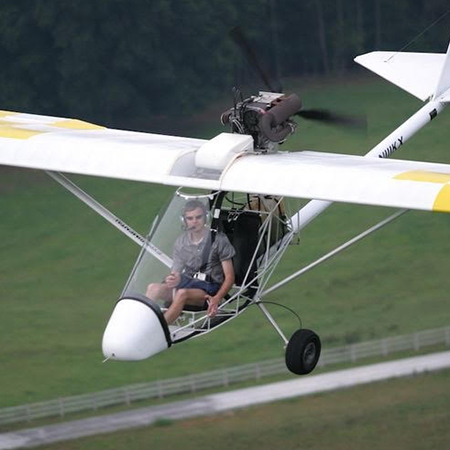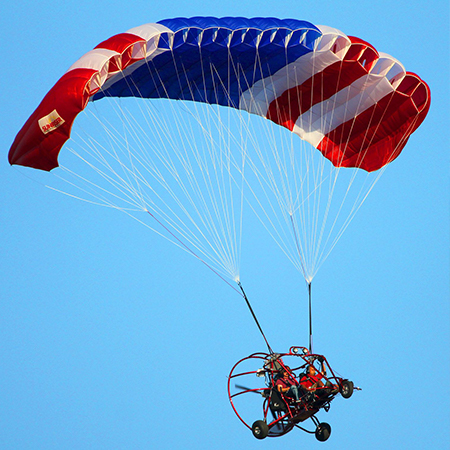ServicesUltra Lights and Powered Parachutes
Annual or 100 Hour Inspection for all Ultralight

Reference FAR Part 43, app. D
Before the inspection, we will remove or open all necessary inspection plates, access doors, fairings, and cowlings, and shall thoroughly clean the vehicle and engine.
Fuselage and Hull
- Fabric and skin.
- Systems and components.
- Envelope, gas bag, ballast tanks and related parts.
Cabin and Cockpit
- Generally.
- Seats and safety belts.
- Windows and windshields.
- Instruments.
- Flight and engine controls,
- Batteries.
- All systems.
Engine and Nacelle
- Engine section.
- Studs and nuts.
- Internal engine including compression and for metal particles or foreign matter.
- Engine mount.
- Flexible vibration dampeners.
- Engine controls.
- Lines, hoses and clamps.
- Exhaust stacks.
- Accessories.
- Cowling.
- All systems.
Landing Gear
- All units.
- Shock absorbing devices.
- Linkages, trusses, and members.
- Hydraulic lines.
- Electrical systems.
- Wheels.
- Tires.
- Brakes.
- Floats and skis
Propeller
- Propeller assembly.
- Bolts.
- Anti-icing devices
- Control mechanisms.
Radio
- Radio and electronic equipment.
- Wiring conduits.
- Bonding and shielding.
- Antenna, including trailing antenna.
Other
- Inspect components of the wing and center section assembly.
- Inspect the components and systems that make up the complete empennage assembly.
- Inspect (where applicable) each installed miscellaneous item that is not otherwise covered by this listing.
- All inspections shall include checks for improper operation, improper installation, poor condition, unacceptable wear, deterioration, defects, or unsatisfactory operation.
Annual or 100 Hour Inspection for Powered Parachutes

Reference FAR Part 43, app. D
Check that registration numbers are visible on the unit and proper in size – 1 ½ inches high for PPCs.
Check that: “TO BE USED FOR INSTRUCTION ONLY”. is visible to persons entering the vehicle in letters at least 1/2” high.
Fuel system
- Fuel tank secure and not leaking, filler cap condition, fuel lines and filter secure and clear (replace annually), fuel pump secure, pulse line new and clamped.
- Fuel Primer secure and operating properly. Lines to and from it replaced annually and clamped – not sagging below frame.
- Check oil reservoir and tubing. Filler cap secure, lines clamped and not deteriorated, mounting secure.
Electrical system
- Check battery mount, battery hold-down, and cables for condition and security.
- Check all electric cables for proper insulation and ends secured. Cables not rubbing on other parts.
- Wiring to switches and instruments. Check secured, ends not frayed, not rubbing on other parts. Instrument pod secured. Mag wires secured, switches secure and not rotating in mount, connectors to engine secure.
- Strobe light mount, control box, and wiring secured – if equipped.
Airframe
- Check frame rails in good condition. All bolts and clamps and brackets secure and tight.
- Fan cage – all bolts and clamps secure. All parts in good condition, secured to pylon.
- Outriggers or halo bars – secured to pylon and/or frontal bars. Cables secured and tensioned properly, bolts tight. CG adjusting bars secured to frame and pinned properly.
- Check underside of airframe for damage or wear or loose components.
- Rudder pedals secure to frame brackets, free moving, pulleys secure if equipped. Control line tied off securely and neatly.
- Inspect nose wheel and steering assembly – all bolts and nuts secure, fender secure, tire inflated, brake secure (if installed) and in good condition.
- Inspect Main wheels and landing gear for condition and security. Check tires inflated, brakes, struts and shocks or spring rods.
- Check seats and seat belts for condition and security. Check operation and anchor points on seat and safety belts.
Canopy
- Canopy steering lines properly routed through guides, pulleys, rings. Steering line condition OK, not frayed or worn through outer cloth.
- Risers – check condition thoroughly for wear, slack, damage. Check attaching points for wear and security.
- Canopy lines – check quick links secure and no worn lines at quick links. Lines in proper order from inside to outside. Check guide pulleys in risers – they must be free-turning and not worn.
- Canopy – clean out all cells and inspect for damage and condition. All attaching points must be inspected. Suck test will help determine canopy condition. Factory inspection recommended.
Engine
- Check mounts secured, studs secure to engine mounting plate, all components secured properly to engine
- Carbs secured to engine, clamps secure and mounting tubes not deteriorated (replace bi-annually). Throttle cables secure in top of carb and splitter secured. Check throttle movement free and even.
- Inspect all wiring on and around engine for security and wear.
- Check spark plugs secure (replace at proper intervals) and wiring and caps in good condition.
- Exhaust manifold must be secure to engine and no sign of leaking. Springs in good condition and safetied properly. Caulk on springs to prevent vibration. Check lower exhaust mounting secured properly and safetied as needed.
- Remove exhausts and inspect pistons and cylinders for wear and/or scoring and hand-verify compression by turning engine over by hand. If in doubt, perform actual compression test with gauge.
- Cooling system – hoses, radiator, secure, clean, fluid level. Check recoil starter for proper operation.
- Rotary valve oil – level OK, fluid not milky, connections secure, filler cap secure.
- Gearbox secured to engine. Filler/drain plugs secured with safety wire. Coupling shows no abnormal slack.
- Propeller – clean all blades and inspect for dings, cracks, separation, abrasion, damage. Repair if needed.
Other
- Radio and communication equipment – check mounted properly, fused if wired direct to battery, cabling secured as needed. Inspect antenna mounting and cabling.
- Accessories secured as needed to prevent damage to prop.
- Inspect (where applicable) each installed miscellaneous item that is not otherwise covered by this listing.
- All inspections shall include checks for improper operation, improper installation, poor condition, unacceptable wear, deterioration, defects, or unsatisfactory operation.

